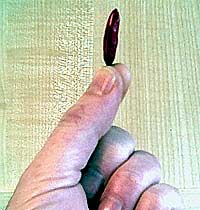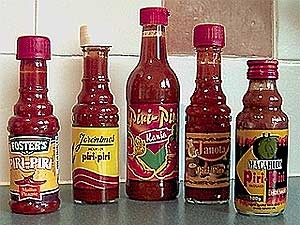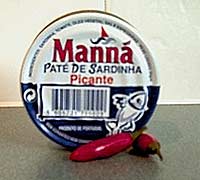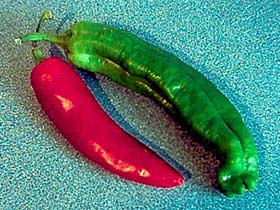By Blaise Lawrence
Recipes:
Molho de Piri-Piri
Caldo Verde
Roasted Pork Piri-Piri
Cataplana de Pescador (Fisherman’s Cataplana)
Frango Piri-Piri (Piri-Piri Chicken)
It all began right after Christmas when my wife Melloney told me what she had done.
“We’re going on holiday to Portugal, Blaise. I’ve booked everything–all you have to do is supply the spending money.”
Now that was a pleasant surprise, and a welcome one for me because I would have a chance to attempt to track down the renowned piri-piri pepper of Portugal. Being an English chilehead (we prefer “chillihead”) who grows chiles in our greenhouse, it was natural for me to turn a vacation into a chile-hunting expedition. And the piri-piri was a suitable quarry, a little fire capsule that has had quite an influence on the cuisine of Portugal. While we’re flying, here’s a little piri-piri history.
Origin: Africa
“Piri-piri” means “pepper-pepper” in Swahili, the pan-African language, and sometimes the chile is called “pili-pili.” It is a generic term that can apply to any member of the Capsicum genus, but in Portugal it specifically refers to a small-fruited variety that resembles a piquin. The question is: how did it get to Portugal? The answer is ironic because after Columbus brought back chile seeds to the Iberian Peninsula on his second voyage to the New World, Portuguese traders carried the seeds to their African colonies of Angola and Mozambique.
An Auspicious Beginning
Soon, spread by birds, traders, and farmers, chiles conquered all of Africa and became an inexpensive way for people to spice up their bland foods. Sometime during this process, traders took small, hot pods back to Portugal where they were called “piri-piri,” the Swahili term. No one knows why the Portuguese adopted the African chile and its name, but I was going to find out how they cooked with the piri-piri–assuming that I could find some.
We arrived at Faro airport in the Algarve by early afternoon to a welcome sight of sun and temperatures in the 60s. We boarded the coach taking us to our holiday resort in Albufeira, arriving only a half-hour later. Food was our first priority, of course. We quickly headed for the open streets with the sun on our backs and our goals in mind. Melloney’s goal was eating but my goal was finding piri-piris. We walked what is known as the Albuferia strip in search of a local grocery store and I was both surprised and excited to bump into our first contact. I spotted an English-looking man returning to his white van and I noticed the lettering on the side: “King Piri-Piri,” surrounded by a logo of piri-piris painted in bright red and green.
I quickly asked for directions to the nearest grocery store and inquired about the piri-piri. I immediately recognized his accent–he came from northern England like myself. He directed us in a gesturing manner to the top of the strip and told us we would find the main grocery store there. He explained that his company was one of the main suppliers in the Algarve and their product was readily available locally–it was a piri-piri powder. I thanked him and vowed to return to a local bar that carried his goods and sample some of the popular local spice.
|
Piri-Piri Sauces |
The visit to the grocery food store was exciting in itself as I wandered the aisles trying to locate the treasured pepper. We selected several bottles of Port, cheeses, and some Madeira and then I stumbled across a gold mine! There was a vast row of chile products: preserved peppers “Piri-Piri” in wine vinegar with spices; sauces like “Macarico Molho Piri-Piri”; Dried “Piri-Piri” in packs; Pâté de Sardinha Picante or sardine pâté made of pulped sardine with tomato, vegetable oil, and of course, piri-piri. I found powders ready to be infused in olive oil with garlic, oregano and a twist of lemon, used in the preparation of Frango Piri-Piri, but no sign of the fresh pods themselves.
|
Pâté de Sardinha Picante |
Melloney pointed out a couple of varieties of fresh chiles in the produce section of the store, but it was quickly apparent that my search was to be in vain. As I poked
around in what I thought were the piri-piris, all were looking rather sorry, being covered in mold and of no use. I did, however select three or four sweet green peppers that looked like a cross between a peter pepper and a New Mexican–a lovely stir-fry I thought to myself! We staggered through the hot, busy streets carrying our shopping bags back to our resort while I pondered where to look next.
|
A Bag of Dried Piri Piri |
The Farm Store
The next day we made our way to reception to see if we could obtain some local information. I greeted the Portuguese man behind the counter in the little lingo I knew– “Bom dia, senhor“–and quickly reverted back to my native tongue: “Please tell me where I could obtain your piri- piri pepper.”
The man looked as if I had asked him for a loan, then turned to a colleague and uttered something in Portuguese and the only words I recognized were “piri-piri.” After a short debate he turned back to me, still confused, and asked what I was after again. I explained that I wished to buy some of the fruits to take back home with me for growing as it was a hobby of mine. I told him that I had seen what I thought were piri-piri in the grocery store yesterday and that they seemed quite large and resembled cayennes. He quickly put me right, telling me that he understood and the peppers I had seen were certainly not piri-piri.
“They are small peppers like this,” he said, drawing on scrap of paper. “My father has two plants about two feet high and the peppers are quite small, but unfortunately he lives way up in the hills and it will be a while before I will see him again.”he rescued me from total disappointment by giving me a photocopied rough map of the area, marking a spot where he explained there was a farm store that might have the pods. I thanked him profusely.
Our car arrived at 10:15 and Melloney ribbed me as I went to get in the wrong door to drive. Oops! Not a good start when you are trying to look like you know what you are doing in a foreign country.
As I tried to get used to the feel of driving on the opposite side of the street, we set off to the market in Loule, where I hoped we would find the treasured little pods. About 40 minutes later, after several wrong turns, we reached our destination. The town was alive and had a real buzz that made us enthusiastic. We managed to find a parking space soon after entering the main square and my abilities and road confidence were again tested as I went to the wrong side for the handbrake and grabbed the seat adjusting bar instead.
We realized that by some fluke we were right outside the main entrance of the market. Old Portuguese men were crowding the pavement outside the bar next door, drinking, smoking. and passing the time of day. As we entered the building, it was like stepping into a WW2 airplane hanger, and the atmosphere was overwhelming. Stalls to the center and sides were in abundance and packed with local treasures.
Where to start I wondered. Melloney gestured toward a stall nearby and I saw saw small ristras and immediately went over to them in eager anticipation. There were several varieties and I quickly recognized a few that were familiar: Friars hat being one, along with several that looked like cayennes. But no piri-piris.
As we walked the center, the hustle and bustle was quite electric and I could hardly hear anything other than raised Portuguese voices. My search was rewarded as once again my eyes caught more ristras hanging from bulging stalls–but these had tiny dried pods and some that were full of plump ripe fruit.
“Piri-Piri?” I asked holding a ristra aloft. A lady approached and nodded agreeably, and as if I had “I am English” tattooed on my forehead, she proceeded to speak to me in my native tongue.
“How much for this?” I asked as I waved the ristra about
“Five hunderd escudos,” she answered and I reached for my wallet with a broad smile on my face. I had found the piri-piri!
Now that I found my chiles, it was Melloney’s turn to shop and we discovered leather goods in abundance–from belts and buckles to handmade bags–plus ceramics galore! All were terracotta and hand painted in beautiful designs. We found fruit and vegetable stalls with locally grown produce ranging from oranges to pomegranates and stalls with mountains of nuts in all shapes and sizes: pine nuts, almonds bigger than I had ever seen, along with peanuts and small bags of raisins.
We returned to the resort shortly after making a purchase of two beautifully painted fish bowls at a give-away price. We stopped by a stall on the way out that carried home made chile sauces and powders. I selected a marinade sauce made with piri-piri, olive oil, sea salt, local herbs, and what a flavor it had!
Time to Dine
Later that evening we both decided that we would like to get away from the resort and find a restaurant out of town. Although the local restaurants were quite good, we still felt there was something better waiting. We were not disappointed as we headed west along the main coastal road towards Portamao.
 |
Dinner for Two, But |
Just on the outskirts of Albufeira, we came across a subtly lit restaurant set back off the road and decided that this looked just the place. On inspection of the menu posted outside we both turned to each other and grinned. The menu was perfect, offering typical Portuguese cuisine and no fish and chips in sight.
A smartly dressed waiter was only too eager to open the door for us and showed us to a lovely table by the window. The menu was extensive and full of local favorites. There was Espardarte Fumado, smoked swordfish, and Caldeirada de Peixe, the Algarve version of the French bouillabaisse–a rich fish stew with potatoes, onions, tomatoes, pimentos, wine, and spices. One of the specialties was Cataplana, the region’s signature dish, named after the wok-like, copper pressure-cooker in which it is prepared. There are several variations of this classic dish, but it usually has clams and spicy Portuguese sausage. Sardinhas, succulent and plump little fish, were served, char-grilled with a light sprinkling of sea salt along with a mixed salad and warm, crusty bread. Also on the menu was Bife de Atum, a beefy fillet of tuna steak, marinated in wine, salt, garlic, and bay leaves, then cooked with onion and bacon.
But I had something spicier in mind. When the waitress returned, I ordered in my best attempt at Portuguese: “Frango Piri-Piri, por favor senhora.” That’s Chicken Piri Piri to you and me. So what are you waiting for? Let’s cook with piri-piris!
Recipes
This is the traditional sauce or marinade that is offered throughout Portugal in restaurants,
cafés, and bars. The recipe can vary a little from place to place, but this is the basic one. Note: This recipe requires advance preparation.
-
1 cup olive oil
-
1.5 tablespoons ground piri-piris or substitute piquin or Thai chles
-
1/2 tablespoon paprika
-
1 clove garlic, minced, or more to tasted
-
2 teaspoons sea salt
-
1/2 teaspoon dried oregano
Combine the ingredients in a jar and shake vigorously. Then store in a refrigerator for a few weeks to blend the flavors
Yield: 1 1/4 cups
Heat Scale: Medium
This is a typical Portuguese soup, here spiced up by the piri-piris. The sausage often contains piri-piri powder and is the same as the chorizo of Spain and Mexico.
-
1/4 cup olive oil 1 large Spanish onion, diced
-
2 garlic cloves, thinly sliced
-
10 ounces chouri?o sausage (chorizo), diced
-
6 medium potatoes, peeled and diced
-
3 dried piri-piri chiles, crushed (or substitute piquin or Thai)
-
8 cups of cold water
1 pound kale or spinach, cut into small julienne Salt and pepper to taste In a large pot, heat the olive oil over medium heat. Add the onions and cook until they are translucent. Add the garlic, half the chouri?o, and the chiles and cook for 2 minutes. Add the potatoes, cover everything with water, bring to a boil and lower the heat, simmering until the potatoes are almost done, about 15 minutes. When the soup is cool enough to handle, puree it in a food processor and return to the pot. Add the greens, and bring everything back to a boil. Lower the heat and simmer for 2 minutes. Season with salt and pepper, ladle into bowls and garnish on top with the remaining cubes of chouri?o. Yield: 6 to 8 servings
Heat Scale: Medium
Here is a recipe with another version of Molho de Piri-Piri, one that is hotter than the one above.
Serve with roasted potatoes and a spinach salad. Note: This recipe requires advance preparation.
-
1/4 cup dried piri-piri chiles or substitute piquin or Thai1 cup olive oil
-
1 lemon slice, cut into quarters
-
1 bay leaf
-
1/2 teaspoon salt
-
1/2 cup brandy or whiskey
-
2 cloves garlic, minced
-
1 red bell pepper
-
4 cloves garlic
-
1 teaspoon. salt
-
4 tablespoons olive oil1
-
2 to 3 pound pork loin, boneless
Combine the chiles, olive oil, lemon, bay leaf, salt, brandy or whiskey, and garlic in a medium saucepan and heat for 15 minutes. Let cool and pour into a glass container. Refrigerate overnight.
Cut the bell pepper into slices and place in a food processor or blender. Add the garlic, salt, olive oil and ½ cup of the shaken up piri-piri sauce. Puree until smooth.
Pour the marinade over the pork loin, cover with plastic wrap, and refrigerate overnight. Preheat oven to 350 degrees and cook the pork for 30 to 40 minutes per pound, uncovered. Slice and serve with pan juices drizzled over the top.
Yield: 6 servings
Heat Scale: Mild
Cataplana de Pescador (Fisherman’s Cataplana)
One of the region’s most notable dishes is named after the wok-like, copper pressure cooker in which it is prepared. It can be made with various ingredients but most commonly clams (ameijoas) along with small pieces of Portuguese spiced sausage (chouriço), garlic, onions, tomatoes, and a little piri-piri. Serve this with boiled new potoatoes.
-
2 tablespoons olive oil
-
2 ounces butter
-
2 medium onions chopped
-
2 cloves garlic, crushed
-
2 pounds clean and rinsed clams
-
2 pounds monk fish fillets, cut into chunks
-
2 large swordfish steaks, cut into strips
-
8 Tiger prawns in their shells
-
3 ½ ounces spiced sausage, chopped
-
4 tomatoes, peeled, seeded and chopped
-
Salt and pepper to taste
-
2 fresh piri-piri chiles, minced (substitute serrano or fresh piquin)
-
1 tablespoon paprika
-
1/2 tablespoon flour
-
3 tablespoons dry white wine
-
1 tablespoon wine vinegar
-
1 sprig parsley, minced
-
1 lemon, halved
In a large skillet, heat the olive oil and sauté the onion and garlic until lightly browned. Place half the onion and garlic on the bottom of a large casserole dish with a tight fitting cover. Add half the clams, half the fish, half the prawns, half the spicy sausage, and half the tomatoes. Season with half the salt and pepper, piri-piri, and paprika. Repeat with a second layer.. Mix the flour with the wine and vinegar and pour over the layers. Put the cover on tightly and cook at a slow simmer for 10 to 15 minutes. Sprinkle with parsley and a squeeze of lemon juice and serve with warm crusty bread and butter.
Yield: 8 servings
Heat Scale: Mild
Frango Piri-Piri (Piri-Piri Chicken)
This dish originates from Africa but was adopted by the Portuguese and is now one of their main dishes served in restaurants, cafés, and bars. It is a simple but tasty dish, and is a fond memory for me. The dish is usually served with crisp hot french fries, but you could serve boiled new potatoes if you prefer. Note: This recipe requires advance preparation.
-
1 medium sized chicken, washed
-
1 cup Molho de Piri-Piri (see recipe)
-
Pinch of ground piri-piri chiles (or substitute piquin or Thai)
-
Pinch of oregano (fresh or dried)
-
Romaine lettuce
-
1 medium red onion, sliced and separated into rings
-
2 large tomatoes, chopped
-
1/4 cup Molho de Piri-Piri (see recipe)
-
1 lemon, sliced for garnish
Place the chicken on a cutting board and split it lengthways at the breastbone (but not in two halves) so that it will lie flat. Then flatten it as much as possible with a mallet. Place the chicken in a shallow glass pan and more the Molho over it. Marinate, covered, in the refrigerator for 3 hours.
Remove the chicken and sprinkle over it some of the ground piri-piri and oregano. Grill the chicken over coals or gas until done. (It can also be baked in the glass pan with the marinade.)
Chop the chicken coarsely.
Arrange the lettuce on four plates, add the onion rings and tomatoes, and top with the chicken. Serve garnished with lemon slices and a small bowl of the Molho as a dressing.
Yield: 4 servings
Heat Scale: Medium













